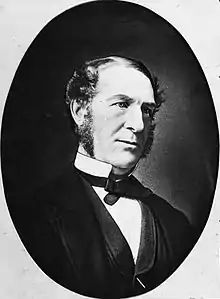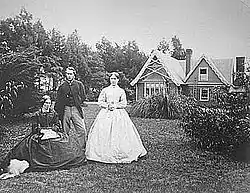William Travers (New Zealand politician)
William Thomas Locke Travers (January 1819 – 23 April 1903) was a New Zealand lawyer, politician, explorer, and naturalist.[1]
William Travers | |
|---|---|
 Travers, c.1879 | |
| Personal details | |
| Born | William Thomas Locke Travers January 1819 Newcastle West, County Limerick, Ireland |
| Died | 23 April 1903 (aged 84) Lower Hutt, New Zealand |
| Relatives | Henry Travers (son) |
| Profession | Lawyer, magistrate, politician, explorer, naturalist, photographer |
Early life

Travers was born near Newcastle West, County Limerick, Ireland, either on 9[2] or 19[3] January 1819. His father chose to retire to France, and Travers was consequently brought up there. He was educated in Saint-Malo, a town in Brittany. In 1835, he joined the British military, and was part of the British Auxiliary Legion that fought in Spain's First Carlist War. After his military service ended, Travers became a lawyer. In 1849, he and his family moved to Nelson, New Zealand, where he continued to practice law. Later, he also lived in Christchurch and Wellington. He purchased Englefield Lodge in Christchurch in 1866 and sold the property in 1872 to Edward Stevens.[4]
Political career
| Years | Term | Electorate | Party | ||
|---|---|---|---|---|---|
| 1853–1854 | 1st | Nelson | Independent | ||
| 1854–1855 | 1st | Waimea | Independent | ||
| 1855–1859 | 2nd | Waimea | Independent | ||
| 1867–1870 | 4th | Christchurch | Independent | ||
| 1877–1878 | 6th | Wellington | Independent | ||
Travers' political career covered both national and provincial politics. He was a member of the 1st New Zealand Parliament, representing first the Town of Nelson and then Waimea electorates, and served in the brief Forsaith Ministry formed by Thomas Forsaith.[5]
In the 1st Parliament, the Town of Nelson was a two member electorate.[6] On nomination day on 25 July 1853, Travers and James Mackay were the only candidates put forward. They were thus declared elected unopposed.[7] Parliament's first term started on 24 May 1854.[8] Travers and William Cautley, MP for Waimea, both resigned on 26 May 1854.[9] Travers subsequently contested the electorate that Cautley had vacated, being elected in the 21 June 1854 Waimea by-election. He was re-elected in the 1855 general election, but was disqualified on 26 July 1859.[10]
Travers returned in the 4th Parliament as representative for the City of Christchurch, after winning the 1867 by-election. He resigned on 29 July 1870 before the end of the term. He was a member of the 6th Parliament as representative for the City of Wellington, having won the 1877 by-election. He resigned on 25 January 1878.[11]
He also served in the councils of Nelson Province and Canterbury Province, and unsuccessfully stood for the superintendency of both. He stood as one of seven candidates for the Nelson Provincial Council in August 1853 in the Town of Nelson electorate, where five seats were elected. He came sixth and was thus not elected.[12]
He represented Wellington in parliament from 1877 to 1881, but was not elected when he stood again in 1893. In Wellington he was City Solicitor, and was an advocate for the west coast railway in 1878. He subsequently became company solicitor to the Wellington and Manawatu Railway Company which built the line north from Wellington to the Manawatu.
His most significant political contribution was his campaign to make central government (rather than provincial government) responsible for education.
Author
Travers was a frequent contributor to scientific journals and was also the author of Stirring Times of Te Rauparaha.
Explorer, naturalist, photographer
At the same time, Travers was also an avid explorer and naturalist, often mounting expeditions into the less well known parts of New Zealand. He was responsible for tracing the source of the Waiau River, and gave the Ada River its name. He also collected many samples of mountain grasses and flowers, sending them to the Royal Botanic Gardens, Kew. Travers was also responsible for drafting the legislation that created the Wellington Botanic Garden, and was a Botanic Garden board member for 22 years.
Death and commemoration
Travers died in an accident at the Lower Hutt railway station on 27 April 1903, when attempting to alight from a moving train. His funeral was held at Lower Hutt, and he was buried in the Bolton Street Cemetery, Wellington.[13][14][15][16][17]
His first wife Jane died in 1888 aged 67y,[18][19][20] and he remarried to Theodora Leslie Barclay in 1891;[21] she remarried to Colonel Edward Wood in 1905.[22][23][24]
So he left a widow (Theodora) from his second marriage, and a son Henry Travers) from his first marriage.[25] His descendants settled in Marlborough.
Mt Travers, the Travers Saddle in the Travers Range, the Travers River in the Travers Valley, Upper Travers Hut and the Travers-Sabine Circuit in Nelson Lakes National Park are named after him, as is the Travers Room at the Rainbow Ski Area.[26]
Notes
- Shepherd, R. Winsome (22 June 2007). "Travers, William Thomas Locke 1819 – 1903". Dictionary of New Zealand Biography. Retrieved 27 March 2010.
- The Cyclopedia of New Zealand – Wellington Provincial District. Vol. Mr. Williiam [sic] Thomas Locke Travers. Wellington: The Cyclopedia Company Limited. 1897. Retrieved 27 March 2010.
- Foster, Bernard John (1966). "TRAVERS, William Thomas Locke (1819–1903)". In McLintock, A. H. (ed.). An Encyclopaedia of New Zealand. Retrieved 27 March 2010.
- "Christchurch's Oldest House". Canterbury Heritage. 7 October 2008. Retrieved 12 March 2011.
- Scholefield 1950, pp. 31, 144.
- Scholefield 1950, p. 161.
- "Election Intelligence". Nelson Examiner and New Zealand Chronicle. Vol. XII, no. 595. 30 July 1853. p. 2. Retrieved 16 February 2011.
- Scholefield 1950, p. 68.
- Scholefield 1950, pp. 100, 144.
- Scholefield 1950, p. 31.
- Scholefield 1950, p. 144.
- "Election of members for the Provincial Council for the Town of Nelson". Nelson Examiner and New Zealand Chronicle. Vol. XII, no. 597. 13 August 1853. p. 7. Retrieved 17 February 2011.
- "Fatal accident". The Press. 1903.
- "Fatal accident". Marlborough Express. 1903.
- "Obituary". The Press. 1903.
- Funeral and burial. 1903.
{{cite book}}:|work=ignored (help) - Obituary. 1903.
{{cite book}}:|work=ignored (help) - "death of Jane Travers". New Zealand Times in Papers Past. 1888.
- "death of Jane Travers". Evening Post in Papers Past. 1888.
- "death of Jane Travers". New Zealand Times in Papers Past. 1888.
- "Marriage of Mr W. T. Locke Travers". Evening Post in Papers Past.
- "Marriage of Mrs Travers". New Zealand Mail in Papers Past. 1905.
- "Marriage of Mrs Travers". New Zealand Times in Papers Past. 1905.
- "Marriage of Mrs Travers". Free lance in Papers Past. 1905.
- "Fatal Accident". Wairarapa Daily Times in Papers Past. 1903.
- Reed, A. W. (2010). Peter Dowling (ed.). Place Names of New Zealand. Rosedale, North Shore: Raupo. p. 420. ISBN 9780143204107.
References
- Scholefield, Guy (1950) [First ed. published 1913]. New Zealand Parliamentary Record, 1840–1949 (3rd ed.). Wellington: Govt. Printer.
External links
- Travers-Sabine Circuit track description